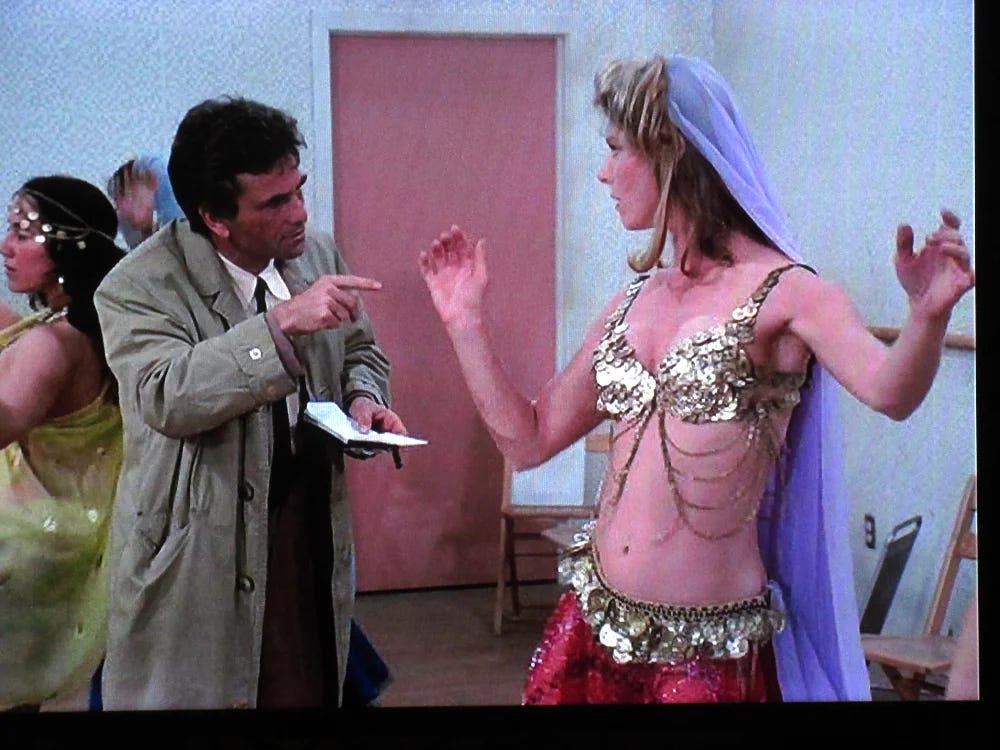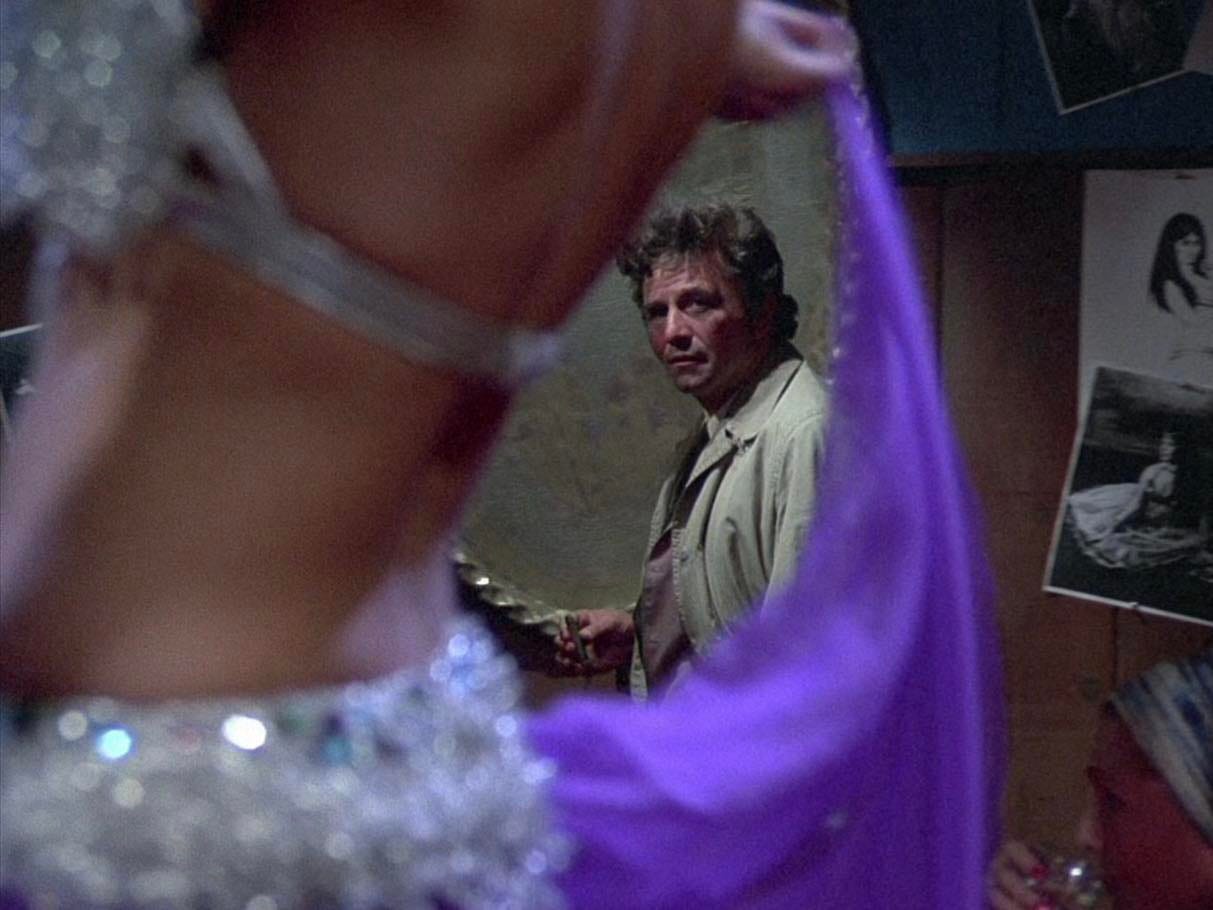One of the saddest Columbo episodes, “Forgotten Lady,” features an aging dancer named Grace Wheeler Willis (played by Janet Leigh) reviving her career. This is one of the few episodes where Columbo doesn’t arrest the killer after finding evidence that proves their guilt. The dancer’s professional partner and former lover takes the blame for the crime because the dancer is dying. Furthermore, this episode makes me love Columbo because he has to convince another cop to take his firearms test for him, as he never carries or uses his gun.
The movie that Grace watches herself in, Song and Dance, was created for the episode and based on That’s Entertainment (1974), which is about the Golden Era of Hollywood. This era includes An American in Paris with Gene Kelly and Swing Time with Fred Astaire and Ginger Rogers. Apparently, Ginger and Fred were offered the lead dancing roles in “Forgotten Lady,” but declined the offer. Hollywood’s Golden Era overlaps with the Golden Era of belly dance in Egyptian films. Columbo is fascinated with belly dancers in two episodes: “Identity Crisis” (1975) and “Try and Catch Me” (1977). I won’t be discussing cultural appropriation or exotification in this essay, but here is a list of resources compiled by Donna Mejia about those topics, which is very much worth exploring. I will be discussing Columbo’s charming reaction to belly dancers.
“Try and Catch Me” is probably my favorite Columbo episode because it features the killer, a mystery author, as the one who utters Columbo’s famous phrase, “just one more thing.” The author’s assistant, Veronica, discovers the author’s crime and blackmails her. But, more importantly, Veronica (played by Mariette Hartley) belly dances, and Columbo interrupts her belly dance class to question her. However, he gets distracted watching the dancing during the interview, tries to ask questions while the dancers circle around him, and can’t seem to escape the circle, which seems like a pleasant place to be stuck. He allows the women to confine him, and have a bit of power over him, since he won’t touch them to get out of their circle.
The belly dance class looks like a beginners class, with zils (fingers cymbals) and full costumes, as if it is a dress rehearsal for a performance. Veronica’s teacher, played by Marie Silva-Alexander, was a belly dancer in real life and co-founded MECDA (Middle Eastern Culture and Dance Association). The costuming here isn’t quite like the costuming in Golden Era of belly dance. For instance, belly dancers of the latter era, like Samia Gamal, wear high-waisted costumes. And it’s unfair to compare Samia’s dancing to Veronica’s, as Samia was one of the greats of the 1950s.
The late 1950s were also when the Fez Supper Club, the first Arab club of its kind in Los Angeles, opened, and it was frequented by many movie stars. There is a documentary film about the Fez, which can be purchased online or seen as part of a membership to Datura online belly dance classes. In addition to the documentary, the club is immortalized in the album Live from the Fez. The Fez was still popular in Los Angeles in the 1970s, when “Try and Catch Me” and “Identity Crisis” were shot and aired. Peter Falk may have been one of the stars to visit the club, but I can’t find any evidence of this online (I want to believe, though). It seems more likely that a writer or producer of the show, which was based in LA, used belly dance in Columbo because of the Fez’s influence.
The Fez is somewhat similar to the club that Columbo visits in “Identity Crisis”: Sinbad’s. In this scene, Columbo struggles to pay attention to the bartender he is supposed to be questioning, instead spellbound by the “interesting” dancer who is on stage. I can’t find the name of this dancer, so please let me know in the comments if you recognize her! I am impressed with her costume (purple being my favorite color), but not her dancing, which seems to be limited to basic shimmies. Columbo notices, from her eyes, that the dancer is shy. Performing belly dance confidently while internally shy is similar to how Columbo presents himself as bumbling and inept to murders in order to con them into revealing evidence that proves their guilt. Also, recognizing that there are different dimensions to her personality shows that she has depth and is not simply an object.
In the 1970s, sentiment in the U.S. towards Arab culture was changing due to the oil industry. The two Columbo episodes portray the art of belly dance in a relatively positive (albeit exotified) light, setting it apart from the bigoted and violent rhetoric that has only escalated since the 70s (especially after 9/11). Columbo looks on admiringly and compliments the dancers, but never makes lewd comments. (And if you’ve performed as a belly dancer, you’ve probably had to deal with some inappropriate remarks and/or touching.) He has an appreciative and respectful gaze, from a distance, never touching the belly dancers and viewing them as complex individuals.



It's interesting to see what you see in media I haven't consumed (and probably never will, given how slowly I watch things). I tried to watch Chippendale's after you wrote about it, and love the lead actor, but it hit too many of my vicarious embarassment buttons. Maybe I'll get back to that at some point. Belly dance is another one of my loves, which often intersects with pole, but the combination makes me doubly concerned about appropriation and exotification.